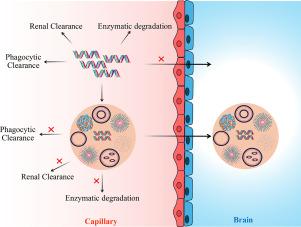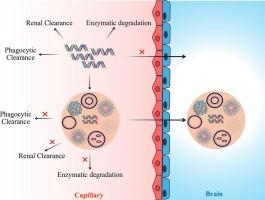脂质和聚合纳米载体siRNA递送至大脑
IF 11.5
1区 医学
Q1 CHEMISTRY, MULTIDISCIPLINARY
引用次数: 0
摘要
脑疾病是指任何损害大脑正常功能的病理状况。这些疾病主要包括神经退行性疾病、脑损伤和恶性肿瘤。研究人员已经探索了各种治疗方法来治疗这些疾病,近年来,基因调节因其明显解决疾病根本原因的潜力而获得了极大的关注。一种有希望的方法是使用sirna作为脑部疾病的治疗剂。大多数siRNA递送到大脑的临床前研究都采用了侵入性脑内方法来靶向特定的大脑区域,这给临床转化带来了重大挑战。与脑内途径相关的挑战突出了对更安全、更实用和患者适应的替代方案的需求,例如全身输送。然而,由于其固有的循环不稳定性和血脑屏障(BBB)的限制性,siRNA的全身递送面临障碍。纳米载体已经成为克服这些挑战的一种有希望的策略。这些纳米载体可以由各种天然、合成或生物材料制成,聚合物和脂质是最常用的,因为它们具有生物相容性、易于表面修饰以靶向、控制药物释放和提高稳定性。在这篇综述中,我们讨论了基于脂质和聚合物的纳米技术策略,旨在克服siRNA递送的挑战,并增强其治疗一系列脑部疾病的潜力。本文章由计算机程序翻译,如有差异,请以英文原文为准。


Lipid and polymeric nanocarriers for siRNA delivery to the brain
Brain diseases refer to any pathological conditions that impair the normal functions of the brain. These mainly include neurodegenerative disorders, brain injuries, and malignant tumors. Researchers have explored various therapeutic approaches to treat these conditions, with gene modulation gaining significant attention in recent years due to its potential to address the root cause of disease. One promising approach is the use of siRNAs as therapeutic agents for brain diseases. Most preclinical studies on siRNA delivery to the brain have employed invasive intracerebral methods to target specific brain regions, posing significant challenges for clinical translation. The challenges associated with the intracerebral route highlight the need for safer, more practical, and patient-compliant alternatives, such as systemic delivery. However, systemic siRNA delivery faces obstacles due to its inherent instability in circulation and the restrictive nature of the blood-brain barrier (BBB). Nanocarriers have emerged as a promising strategy to overcome these challenges. These nanocarriers can be made from various natural, synthetic, or biological materials, with polymers and lipids being the most commonly used due to their biocompatibility, ease of surface modification for targeting, controlled drug release, and improved stability. In this review, we discuss lipid- and polymer-based nanotechnology strategies aimed at overcoming the challenges of siRNA delivery and enhancing its therapeutic potential for treating brain diseases.
求助全文
通过发布文献求助,成功后即可免费获取论文全文。
去求助
来源期刊

Journal of Controlled Release
医学-化学综合
CiteScore
18.50
自引率
5.60%
发文量
700
审稿时长
39 days
期刊介绍:
The Journal of Controlled Release (JCR) proudly serves as the Official Journal of the Controlled Release Society and the Japan Society of Drug Delivery System.
Dedicated to the broad field of delivery science and technology, JCR publishes high-quality research articles covering drug delivery systems and all facets of formulations. This includes the physicochemical and biological properties of drugs, design and characterization of dosage forms, release mechanisms, in vivo testing, and formulation research and development across pharmaceutical, diagnostic, agricultural, environmental, cosmetic, and food industries.
Priority is given to manuscripts that contribute to the fundamental understanding of principles or demonstrate the advantages of novel technologies in terms of safety and efficacy over current clinical standards. JCR strives to be a leading platform for advancements in delivery science and technology.
 求助内容:
求助内容: 应助结果提醒方式:
应助结果提醒方式:


